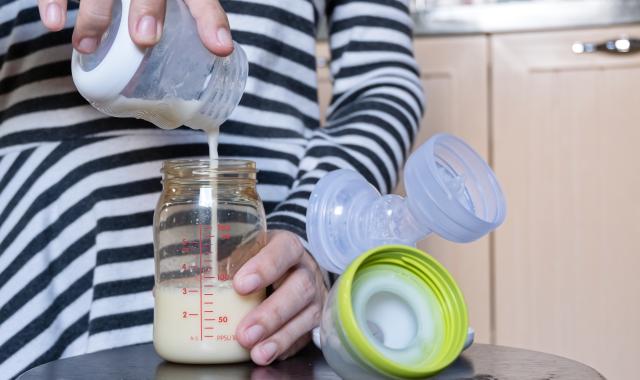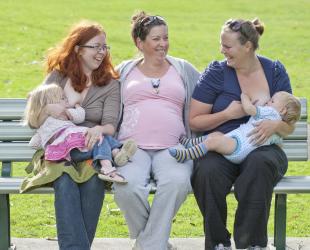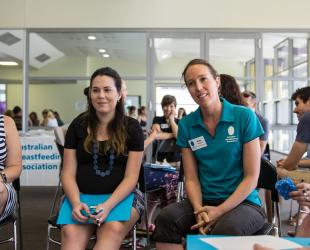Information for mothers who want to exclusively breastfeed or reduce top-ups
by Simone Casey

I chat to heaps of mums who are in a routine of topping up their newborns with expressed breastmilk or formula after feeds. The reason these little ones are prescribed this extra milk varies hugely depending on the health professional they are working with. Sometimes babies are born a little early and don’t quite get it yet, are fussy and difficult to attach, uncoordinated suckers, haven’t regained their birth weight, or maybe have a condition like tongue-tie or poor muscle tone. Whatever the reason, the expressing, preparing the top-ups and washing the bottles (not to mention sterilising if you’re using formula) is all very time consuming — time mums would rather spend with their babies.
Topping up your baby doesn’t mean you’ll always have to. But there is very little information out there on how to stop the top-ups. In fact, many a breastfeeding relationship has come to an abrupt halt because the mum finds they are having to put more and more milk in the bottle, their milk supply gets lower and lower and suddenly, they are bottle-feeding without actively making that choice. One of the first steps to reducing these top-ups is to work out a plan. Chatting to an ABA counsellor or an IBCLC-qualified lactation consultant is a great place to start.
My plan of attack with these babies is, first, treat the problem. Work out why they needed the top-ups in the first place. If it’s bad attachment, work on that. If there’s a suspected tongue-tie or weak suck, have baby assessed. If baby is sleepy or not gaining enough weight, teach the mum to switch feed. That’s a feeding technique where mums swap back and forth, back and forth from one breast to the other (so four breasts per feed), rousing baby in between sides with a nappy change, and using heaps of breast compressions any time the baby pauses for too long, which squirts a jet of milk into their mouth and reminds them to keep going. Rubbing firmly on the sole of the foot is also a great rousing technique (not light tickling your fingers over their skin, I reckon that sends babies into a deeper slumber!).
The actual top-ups can only be reduced if baby is given as much opportunity to feed at the breast as possible. One way is to simply offer the breast first, at every single feed. Don’t be disheartened if baby is fussy, and don’t blame yourself or your milk. Be confident. Your body CAN nourish your baby. Persist, but don’t turn yourself into an emotional mess if it doesn’t work. Relaxing is the only way you’ll be able to have a baby calm enough to feed. Get onto the feed quickly. As soon as baby is stirring from sleep, strip yourself off and place baby skin-to-skin on your chest. It’s a lovely place for them to wake up, all safe and calm and they will likely start to look for the breast on their own, if given the chance. Offer four sides. If baby doesn’t settle and you think they are looking for the top-up, give a small one (in a cup or bottle), but rest after every 10 mL or so to see if your baby settles. The less top-up you can give, the more hungry they’ll be for the breast at the next feed. Most importantly, while you are reducing top-ups, watch your baby’s nappies. We like to see at least 5 heavily wet single-use nappies in 24 hours. You can also check in for a few extra weigh-ins with your child health nurse to make sure you’re on track.
Oh, and enlist a cheer squad of like-minded people to emotionally support you through this time: Open-minded, positive types who support your breastfeeding choices. For some, this plan may work quickly. For others it may crawl along at a snail pace. Progress is progress, whether it’s a 10 mL reduction a day or a week. You are on your way to exclusively breastfeeding your baby. Claps from me.
For more information on increasing your supply naturally, check out the Australian Breastfeeding Association website: aba.asn.au/supplyBWABAblog
And for further information on weaning from formula supplements: aba.asn.au/weanformulaBWABAblog
Simone Casey is an Australian Breastfeeding Association counsellor and community educator from Northern Melbourne. She’s breastfed three children over nine years and has been volunteering with ABA for over 13 years, with a 6-year stint as group leader of the Pascoe Hume Group and several years as regional representative of the Tullamarine Region. Simone was a journalist for 20 years so has loved combining her writing skills with her breastfeeding knowledge to create blogs for the national website and now recording this podcast series. In 2011 she qualified as an International Board Certified Lactation Consultant and works in a private inner city hospital and runs her own lactation business doing home visits. Her volunteering highlight was at a branch conference in Ballarat when a trainee referred to her as ‘the Kylie Minogue of breastfeeding’.
More information
Have you been advised to give extra milk besides breastfeeds? This is known as giving a top-up feed and it is often only needed as a temporary measure. Unfortunately, many mums find that they have been caught in a cycle of topping-up and they don’t know how to stop. In this episode, Jessica and Simone chat about some of the things you can do to breastfeed more and stop, or at least reduce, the top-ups.
- Access our free info kit.
- Download our mum2mum app via the App store or Google Play.
- Call the National Breastfeeding Helpline on 1800 686 268, available 24 hours a day, 7 days a week.
- Chat with a volunteer via LiveChat on our website.
- Sign up for an interactive and informative local breastfeeding class or online breastfeeding workshop.
- Get books and resources on general and specialist breastfeeding topics.
- Join ABA as a member to get your free copy of our best-selling book Breastfeeding … naturally + free access to all premium content on the mum2mum app + discounted breastfeeding classes + half-price breast pump hire + unlimited access to ABA events + more!



